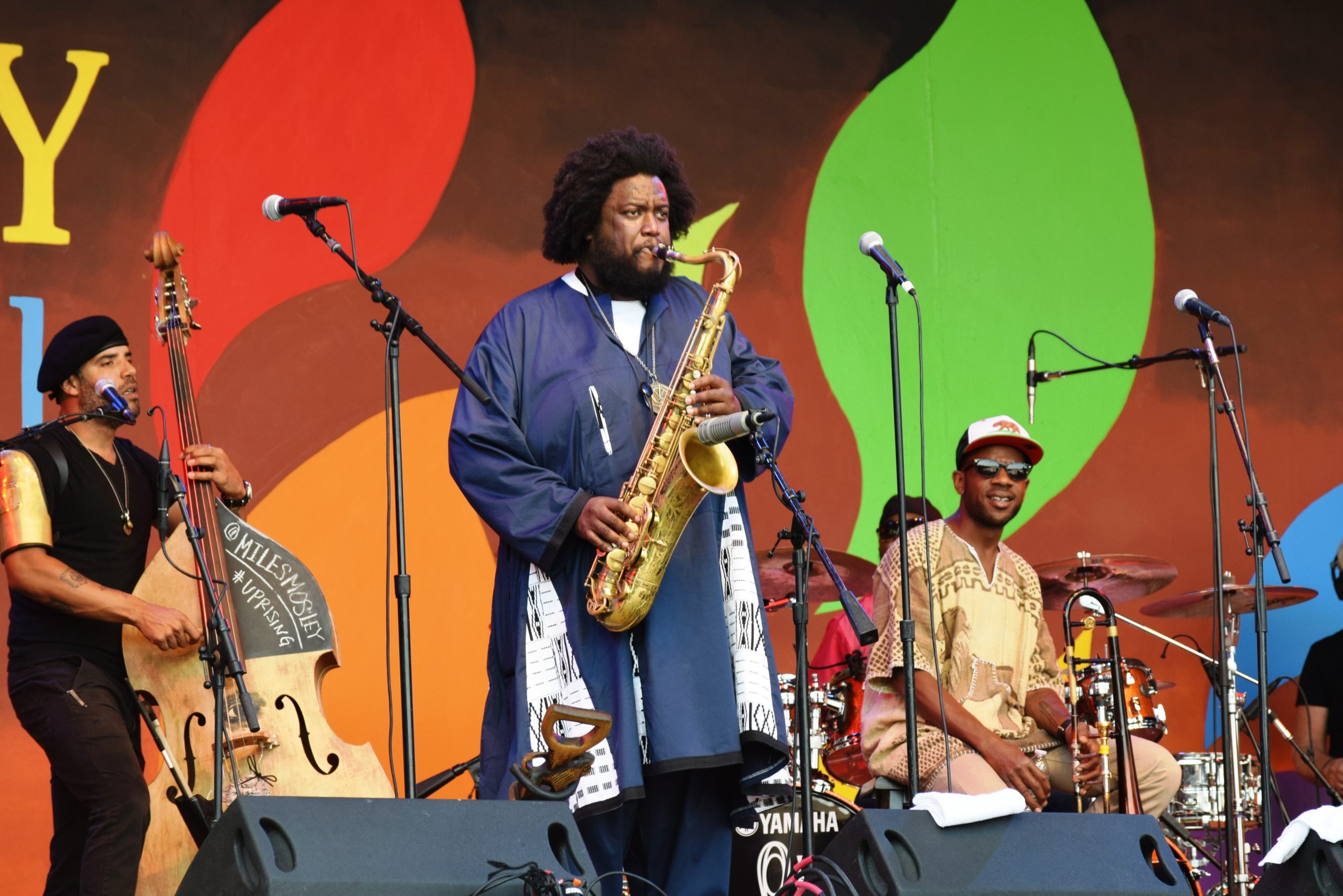
By Barbara Smith – Photos by ESE
 It’s hard for the Monterey Jazz Festival to outdo itself, but Fest #59, held last weekend at the idyllic seaside Monterey Fairgrounds, will surely go down in history as a landmark event beginning with a luminous opening night tribute to iconic conductor/arranger/musician Quincy Jones. “I’ll never forget this night as long as I live,” Jones exclaimed at the MJF’s Friday night celebration: “Tribute to Quincy Jones: The A & M Years.” And neither will the hundreds of fans who packed the Jimmy Lyons Arena, bewitched by a showcase of Jones’ incredible and multi-dimensioned talent. Drawing from three groundbreaking albums—“Walking in Space,” “Gula Matari,” and “Smackwater Jack,” which were forged during the tumultuous years 1969 – 1972, and with the sublime backing of an all-star group including Christian McBride, Dave Grusin, Hubert Laws and conducted by John Clayton, a magical aura enveloped the Arena. The late 60’s and early 70’s was a watershed era when black pride flourished, coloring the musical landscape in rich and beautiful hues. Listeners were transported back in time with the vocals of songstress/songwriter Valerie Simpson (Grusin, Laws and Simpson all performed on the original recordings), whose still shimmering and soulful voice brought the set to astonishing heights on “Walking in Space.” “Killer Joe,” also from “Walking in Space,” and Jones’ unique arrangement of the Marvin Gaye classic “What’s Going On” from the “Smackwater Jack” album were also highlights. The hits kept coming as with beautifully executed arrangements of some of Jones’ most famous TV compositions, including the theme from “Ironside.”
It’s hard for the Monterey Jazz Festival to outdo itself, but Fest #59, held last weekend at the idyllic seaside Monterey Fairgrounds, will surely go down in history as a landmark event beginning with a luminous opening night tribute to iconic conductor/arranger/musician Quincy Jones. “I’ll never forget this night as long as I live,” Jones exclaimed at the MJF’s Friday night celebration: “Tribute to Quincy Jones: The A & M Years.” And neither will the hundreds of fans who packed the Jimmy Lyons Arena, bewitched by a showcase of Jones’ incredible and multi-dimensioned talent. Drawing from three groundbreaking albums—“Walking in Space,” “Gula Matari,” and “Smackwater Jack,” which were forged during the tumultuous years 1969 – 1972, and with the sublime backing of an all-star group including Christian McBride, Dave Grusin, Hubert Laws and conducted by John Clayton, a magical aura enveloped the Arena. The late 60’s and early 70’s was a watershed era when black pride flourished, coloring the musical landscape in rich and beautiful hues. Listeners were transported back in time with the vocals of songstress/songwriter Valerie Simpson (Grusin, Laws and Simpson all performed on the original recordings), whose still shimmering and soulful voice brought the set to astonishing heights on “Walking in Space.” “Killer Joe,” also from “Walking in Space,” and Jones’ unique arrangement of the Marvin Gaye classic “What’s Going On” from the “Smackwater Jack” album were also highlights. The hits kept coming as with beautifully executed arrangements of some of Jones’ most famous TV compositions, including the theme from “Ironside.”
The legendary 83-year-old record producer, conductor, arranger, composer, musician, television and film producer’s career spans six decades in the entertainment industry and a record 79 Grammy Award nominations and 28 Grammys, including a Grammy Legend Award in 1991.
“Bebop, doo wop, hip hop– I’ve been a bebopper all my life, and always will be,” Jones shared as he took the stage to extended applause. “All I’ve wanted to do is connect all the genres.” The connections continued on Saturday in Dizzy’s Den in a lively conversation between Jones and Clint Eastwood during which the two trailblazers of music and film shared their mutual journeys and musical passions. Eastwood, who sits on the board of the MJF, and Jones have been friends and collaborators for years. Both have continued to push their careers forward while others have retired. Said Eastwood, “I’ve always thought jazz and the Western movie were the true American art forms,” and certainly both helped influence these genres throughout the world. Some funny and interesting facts and observations that surfaced in their conversation: Ray Charles taught Jones how to read music in Braille; Jones’ pet nickname for Eastwood, who he has known since Eastwood’s teen years, is DNA—Damn Near African; Frank Sinatra, whom Jones described as “one of the best friends you could ever ask for, sang like a jazz saxophone player”; Jones’ boundary-busting career is underscored by the truth in his observation that “Jazz players were the first to integrate. All I need to know is ‘Can you play, brother?’ The world needs to learn from that.”
Another side of the jazz spectrum was showcased on Saturday with Maceo Parker, funk and soul jazz saxophonist, best known for his work with James Brown in the 1960s, who, in a performance that showcased his versatility and showmanship, performed an ultimate tribute to Ray Charles. Parker took the stage in full Charles regalia—natty red and black suit, black shirt, bow tie, dark glasses—and swayed to the music in the signature Charles manner, so that one could imagine oneself at a concert of the master jazz and bluesman Charles. With the only nod to his own musical virtuosity, Parker lifted his sax and blew “Hallelujah, I Just Love Her So,” leaving the audience clamoring for more in a most sweet and satisfying set.
Sunday’s highlights included the always impressive MJF New Generation Orchestra, a select group of high school students who are carrying the mantle of jazz forward, led by the extraordinary drummer/vocalist/bandleader Terri Lyne Carrington, this year’s Artist-in-Residence, and accompanied by a return electrifying performance by Valerie Simpson; soul-jazz singer/songwriter Gregory Porter, whose heavenly vocals on “Don’t Lose Your Steam,” “In Heaven,” “Take Me to the Alley” cross genres in rich, deep, soulful tones, lifted by a generous and healing spirit. Queues for his autographed CD and selfies with the rising star snaked throughout the fairgrounds. Kamasi Washington, who appeared at Monterey in ’07 as a youth in the Gerald Wilson Orchestra, blew his sax to the rafters on the Arena stage with self-penned stunners like “Henrietta Our Hero,” a valentine to his grandmother, made all the more special when joined by his father Rickey Washington on flute (“I learned everything I know from him,” the younger Washington said).
Among other headliners were Showcase Artist Joshua Redman; Commission Artist Wayne Shorter; vocalist extraordinaire Cecile McLorin Salvant; the Branford Marsalis Quartet with special guest Kurt Elling; and guitar slinger Pat Methany. Rising jazz prodigies 13-year-old pianist from Bali Joey Alexander and multi-instrumentalist London-based 22-year-old Jacob Collier thrilled crowds with featured spots on the program.
As ever, MJF seeks to nurture opportunities for youngsters with its jazz education program. For Ayana Bradley of Seaside, the Festival and its outreach to youth has been an inspiration. A student of piano, Bradley was part of the Monterey County All Star Band for three years and performed this year at the education booth. “This festival is life-changing,” said the young musician who now attends Willamette University in Oregon, majoring in music and international studies. “Jazz is America’s music and this is a community that loves and supports jazz and invests in young people to keep it alive and moving forward.”


